French vedette Sarah Bernhardt (1844-1923) has been referred to as 'the most famous actress in the history of the world'. She made her fame on the stages of Europe in the 1870s, and was soon highly in demand in both Americas too. 'The Divine Sarah' was also one of the first film stars. What a woman!
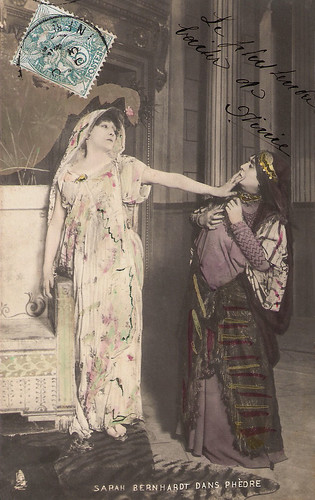
French postcard by Raphael Tuck & Fils, Editeurs, Paris, Serie 203. Sent by mail in 1903. Caption: Sarah Bernhardt in Phèdre. Bernhardt played the title role in Jean Racine's Phèdre for the first time in 1874. She retook the part in 1899 when Bernhardt took over the former Théâtre des Nations on the Place du Châtelet. The Théâtre Sarah-Bernhardt opened on 21 January with Victorien Sardou's La Tosca in which Bernhardt played the title role, one of her most admired parts. This was followed by a revival of Phèdre on 24 February.
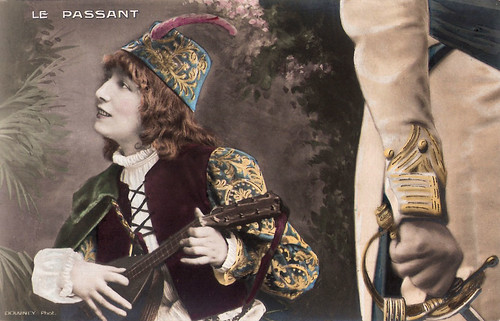
French postcard. Photo: Downey. Publicity still for the play Le Passant, by François Coppée. In 1869, after her command performance for Napoleon III as as the Florentine minstrel Zanetto (in travesty) in Coppée’s Le Passant, Sarah Bernhardt was on the verge of stardom.

French postcard. Photo: Boyer. Sarah Bernhardt debuted in Alexandre Dumas fils's play La Dame aux Camélias in 1880. It became one of her most beloved and most performed plays. In 1911 Bernhardt would act in a silent film version as well, directed by André Calmettes and Henri Pouctal. This postcard is from the early 20th century. The card depicts the dead Marguerite Gauthier, deplored by her lover Armand Duval.
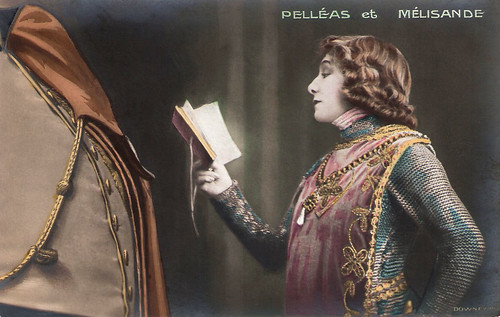
French postcard. Photo: Downey. Publicity still for the stage production of Maurice Maeterlinck's play Pelléas et Melisande/Pelléas and Melisande in 1904.
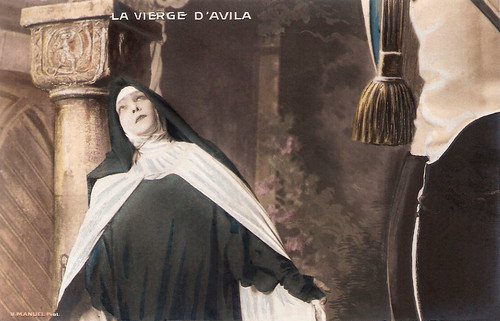
French postcard. Photo: H. Manuel. Sarah Bernhardt as Soeur Therese in the play La Vierge d'Avila composed by Reynaldo Hahn and written by Catulle Mendes. 1906 performance at Theatre Sarah-Bernhardt.
Sarah Bernhardt was born in 1844 in Paris as Henriette-Rosine Bernard. Her mother was the Dutch-born Julie Bernardt and her father was unknown. Julie was a courtesan, known by the name Youle. Julie had five daughters, including a twin who died in infancy in 1843. Henriette-Rosine changed her first name and added an 'h' to her surname. Her birth records were lost in a fire in 1871. To prove French citizenship - necessary for Légion d'honneur eligibility - she created false birth records, in which she was the daughter of 'Judith van Hard' and 'Édouard Bernardt' from Le Havre, in later stories either a law student, accountant, naval cadet or naval officer.
When Sarah was young her mother sent her to Grandchamp, an Augustine convent school near Versailles. In 1860 she began attending the Conservatoire de musique et de déclamation in Paris and eventually became a student at the Comédie Française where she would have her acting debut in 1862 in the title role of Jean Racine's Iphigénie to lacklustre reviews. Her time there was short-lived; she was asked to resign after slapping another actress across the face for shoving her younger sister during a birthday celebration for Molière.
Bernhardt decided to leave France, and soon ended up in Belgium, where she became the mistress of Henri, Prince de Ligne, and gave birth to their son, Maurice, in 1864. After Maurice's birth, the Prince proposed marriage, but his family forbade it and persuaded Bernhardt to refuse and end their relationship. She resumed the life of a courtesan to which her mother had introduced her at a young age, and made considerable amounts of money during that period (1862–1865).
Bernhardt then reverted to the theatre, securing a contract at the Théâtre de L’Odéon where she began performing in 1866. Her most famous performance there was her travesty performance as the Florentine minstrel in François Coppée's Le Passant (1869). With the outbreak of the Franco-Prussian War performances were stopped and Bernhardt converted the theatre into a makeshift hospital where she took care of the soldiers wounded on the battlefield. In 1872, she left the Odéon and returned to the Comédie-Française. One of her remarkable successes there was in the title role of Voltaire's Zaïre (1874).

French postcard by Neurdein Frères, Photo-Edit., no. 25. Photo: Nadar. Bernhardt as Empress Theodora in Victorien Sardou’s Theodora (1884).
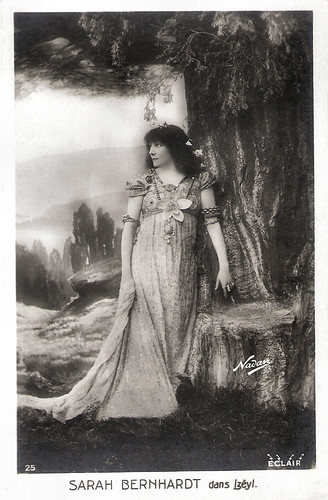
French postcard by Eclair, no. 25. Photo: Nadar. Publicity still for the 1894 stage play Izéil by Eugène Morand and Armand Silvestre.

French postcard. Bernhardt in the title role of William Shakespeare's Hamlet (1899).
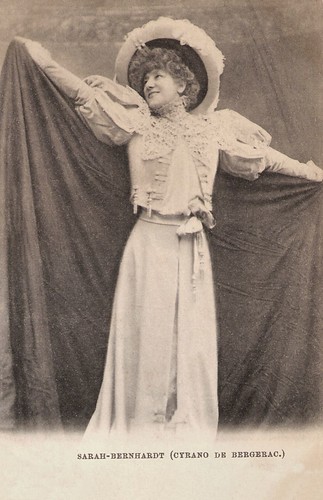
French postcard. Photo: publicity still for a 1900 production of the stage play Cyrano de Bergerac (1900) by Edmond Rostand, in which Bernhardt played the role of Roxane.
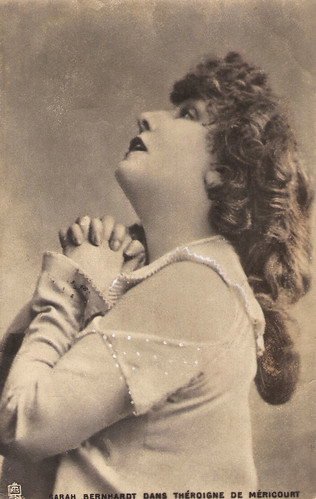
French postcard by Raphael Tuck et Fils Ltd Editeurs, Paris, Serie 569. Publicity still for the stage production of Theroigne de Mericourt (1902), a play by Paul Hervieu. Anne-Josèphe Théroigne de Méricourt (1762–1817) was a singer, orator and organiser in the French Revolution. She is known both for her portrayal in the French Revolutionary press and for her subsequent mental breakdown and institutionalisation.
During the 1870s, Sarah Bernhardt made her fame on the European stages and was soon in demand all over the world. Her first tour of the United States and Canada took place in 1880-1881 (157 performances in 31 cities). In 1887 she toured South America. In 1888 she toured Italy, Egypt, Turkey, Sweden, Norway and Russia. In 1891-1892 she took part in a worldwide tour which included much of Europe, Russia, North & South America, Australia, New Zealand, Hawaii and Samoa. Another tour of America took place in 1896. 1901 saw her 6th American Tour, 1906 her 7th (her first 'Farewell Tour'), 1910 her 8th, and 1913-1914 her 9th.
She developed a reputation as a serious dramatic actress, earning the title 'The Divine Sarah'. However, she also participated in scandalous productions such as John Wesley De Kay's Judas. In this play Mary Magdalene, who at first became a lover of Pontius Pilate, then of Judas Iscariot (played by Bernhardt!), got involved with Jesus. Judas, after realising that Mary Magdalene had given herself to Jesus, decided to betray his friend to the Romans. The play performed in New York’s Globe Theatre for only one night in December 1910 before it was banned there, as well as in Boston and Philadelphia.
In between her international tours, Sarah Bernhardt took over the lease of the Théâtre de la Renaissance, which she ran as producer-director-star from 1893 to 1899. She coached many young women in the art of acting. In 1899 Bernhardt took over the former Théâtre des Nations on the Place du Châtelet, renaming it the Théâtre Sarah-Bernhardt. She opened it in the title role in Victorien Sardou's La Tosca and many of her famous roles, such as her Hamlet in travesty, followed.
Bernhardt continued to direct the Théâtre Sarah-Bernhardt until her death, when her son Maurice took over. After his death in 1928, the theatre retained the name Sarah Bernhardt until the Occupation by the Germans in World War II, when the name was changed to Théâtre de la Cité because of Bernhardt's Jewish ancestry.
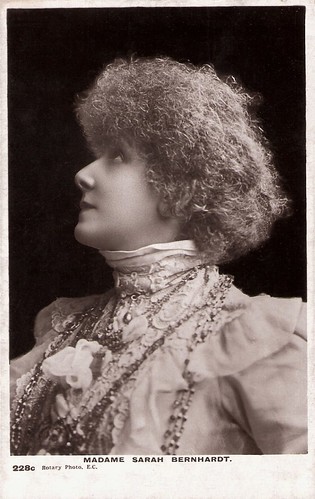
British postcard by Rotary Photo Co., London, no. 228C.
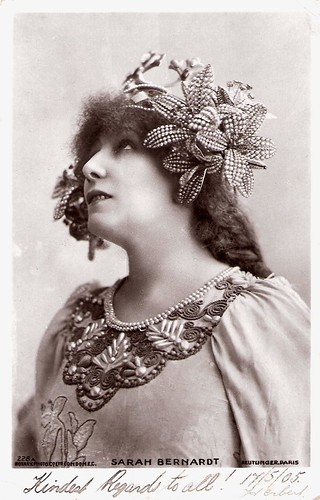
British postcard by Rotary Photo Co., London, no. 228A. Sent by mail in 1905. Photo: Reutlinger, Paris.
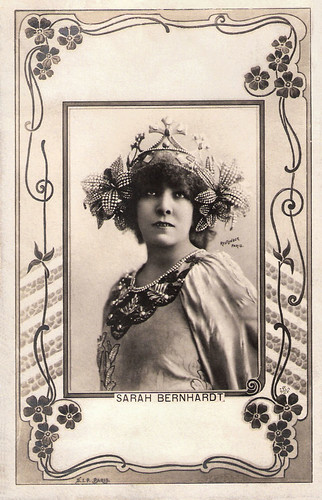
French postcard by S.I.P., Paris. Photo: Reutlinger.

Tinted, vintage postcard. Collection: phheww.

German postcard, no. 2329. It was sent from Leipzig, Germany to Laibach, Austria (now Ljubljana, Slovenia) on 31 October 1905. The author used the Greek alphabet. We deciphered the text and discovered that he wrote in German and signed as Hugo Reizenbach. The addressee was one Christl Kantz, maybe his secret girlfriend?
The beautiful postcards above are probably the best known images of Sarah Bernhardt. On each postcard she wears the same outfit and a huge crown-like diadem. This 'Lilies' diadem for was designed by poster designer Alphonse Mucha and created by the famous French jewelry designer René Lalique.
The photographs for the postcards were made by the Reutlinger Studio in Paris, which took photos of the rich and famous between 1850 and 1937. The Reutlinger studio was founded in 1850 by German-born photographer Charles Reutlinger. In 1880, he passed the studio on to his brother Emile, who ran the studio until 1890. In 1883, Emile’s son Léopold came to Paris from Callao, Peru, where he grew up. Léopold Reutlinger took over in 1890, and he developed a very successful postcard business.
P.K. Hobbs at Everything Vintage: "Léopold introduced a very distinctive style of merging photographic images with art nouveau fantasy overlays. He added to that process exceptionally well-done hand tinting. The Reutlinger Studio became known for their unusual art nouveau styles of postcard designs, especially for portraits of actresses. These postcards were not cheaply produced, nor were they cheaply sold. This part of his business was very successful and sought-after, as thousands of his art nouveau postcards were produced."
The photos for the postcards above were publicity stills for the stage play La princesse Lointaine by Edmond Rostand. Sarah Bernhardt wore the diadem for the first time in this play at the Renaissance Theatre in Paris in 1895.
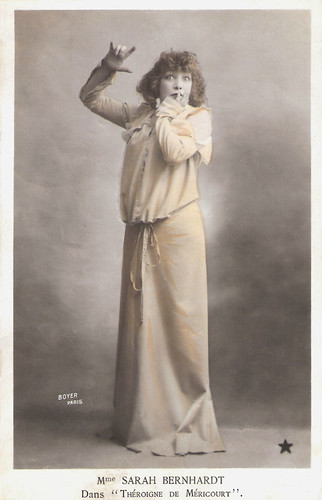
French postcard. Sent by mail in 1906. Photo: Boyer, Paris. Publicity still for the play Théroigne de Méricourt, by M. Paul Hervieu, presented at the Théâtre Sarah Bernhardt in 1902.
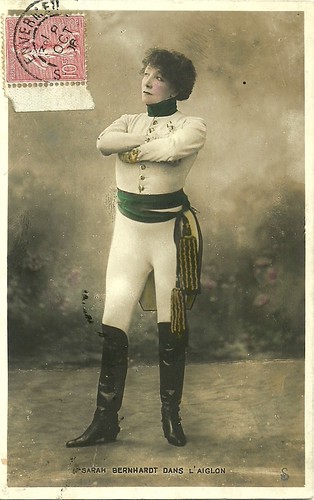

French postcards, both sent by mail in 1908. Photos: publicity stills for her stage play L'aiglon.
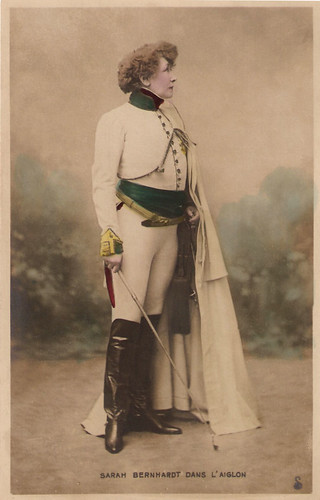
French postcard. Photo: Sarah Bernhardt in L'Aiglon. L'Aiglon is a play in six acts by Edmond Rostand based on the life of Napoleon II, who was the son of Emperor Napoleon I and his second wife, Empress Marie Louise. The title of the play comes from a nickname for Napoleon II, the French word for 'eaglet' (a young eagle). The title role was created by Sarah Bernhardt in the play's premiere on 15 March 1900 at the Théàtre Sarah Bernhardt. Rostand had written L'Aiglon specifically for Bernhardt, and it became one of her signature roles.
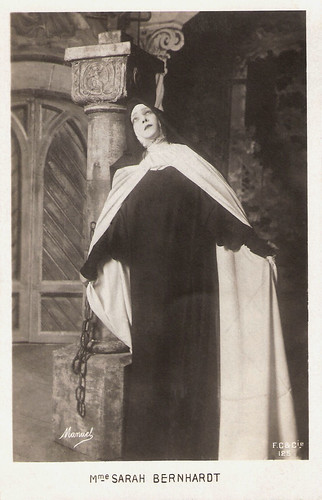
French postcard by F.C. & Cie, no. 125. Photo: Manuel. Sarah Bernhardt as Soeur Therese in La Vierge d'Avila composed by Reynaldo Hahn and written by Catulle Mendes. 1906.
Sarah Bernhardt had a sporadic love-hate affair with the early cinema. In 1900, she made her first film, the two-minute long Le Duel d'Hamlet/Hamlet (Clément Maurice, 1900). Technically, this was not a silent film, as it had an accompanying Edison cylinder with sound effects.
After her film début Bernhardt declared she detested the medium. However, in the following decades she consented to star in eight motion pictures and two biographical films. The latter included Sarah Bernhardt à Belle-Isle/Sarah Bernhardt at Home (1912), a film about her daily life with her family and friends.
In 1908 she featured in her second film, based on Victorien Sardou's Tosca, condensed to a one-reel film. Upon seeing La Tosca (1909), she reportedly recoiled in horror, demanding that the negative be destroyed.
Nevertheless, soon followed her leading role in the Film d'Art production La dame aux camélias/Lady of the Camelias (Louis Mercanton, 1911), released in the US as Camille. It was a two-reel condensation of the play with handsome Dutch actor Lou Tellegen as Armand Duval. The film was a critical and popular success, and it helped to give the cinema artistic dignity.
The handsome Dutch-born Lou Tellegen was again Bernhardt's co-star in her next film, Les amours de la reine Élisabeth/Queen Elisabeth (Henri Desfontaines, Louis Mercanton, 1912), filmed in Britain. The massive receipts from this film's distribution in the US provided Adolph Zukor with the funds to found Paramount.
Bernhardt, at 69, was offered a fortune to make films with other companies, but she stayed with Film d'Art. She next appeared in Adrienne Lecouvreur (Henri Desfontaines, Louis Mercanton, 1913) with Max Maxudian and again Lou Tellegen.

French postcard by S.I.P., 72e Serie, no. 7.
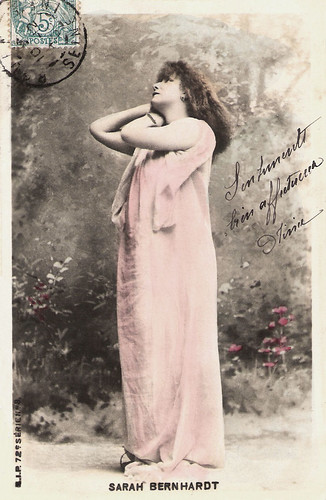
French postcard by S.I.P., series 72, no. 8.
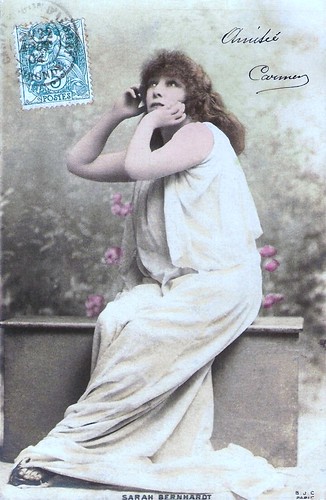
French postcard by BJC, Paris. Sent by mail in 1904.
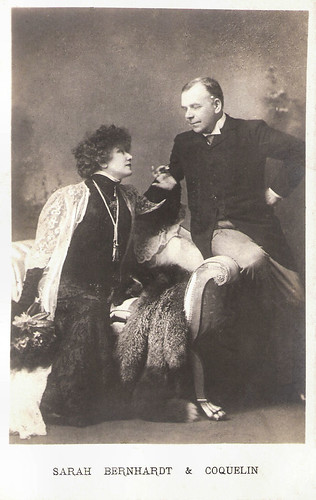
French postcard. Sarah Bernhardt and colleague Benoît-Constant Coquelin, known as Coquelin aîné (Coquelin the Eldest), known as one of the greatest theatrical figures of the age. In 1900 Bernahardt and Coquelin toured together in America. They appeared on Broadway's Garden Theatre in a production of Cyrano de Bergerac (Coquelin as Cyrano and Bernhardt as Roxane). On their return to France they appear together in L'Aiglon, at the Théâtre Sarah Bernhardt.

French postcard by PMM. Photo: Nadar, Paris. Sent by mail in 1901.
During the First World War, Sarah Bernhardt played in two war propaganda films, the intimate drama Jeanne Doré (René Hervil, Louis Mercanton, 1915) and the highly patriotic Mères françaises/Mothers of France (René Hervil, Louis Mercanton, 1917).
In between these two films, she had lost a leg. In 1905, while performing in Victorien Sardou's La Tosca in Teatro Lírico do Rio de Janeiro, Bernhardt injured her right knee when jumping off the parapet in the final scene. The leg never healed properly. By 1915, gangrene set in and her entire right leg was amputated; she was required to use a wheelchair for several months.
Bernhardt continued her career, sometimes without using a wooden prosthetic limb, which she did not like. She carried out a successful tour of America in 1917 (her 10th), and on returning to France she played in her own productions almost continuously until her death. Later successes included Daniel (1920), La Gloire (1921), and Régine Armand (1922). The amputation was not apparent during her performances, which were done with the use of the artificial limb. The charm of her voice, which had altered little with age, ensured her triumphs.
Her last film was La Voyante/The Fortune Teller (Leon Abrams, Louis Mercanton, 1923) with Harry Baur. By then she was 79 and already mortally ill. Her hotel room was turned into a studio. But her failing health halted production and she died before the film was completed. Her stand-in had to complete her scenes, with her back to the camera.
Sarah Bernhardt passed away on 26 March 1923 in Paris. The cause of death was uraemia (urea in the blood) following after kidney failure. From 1882 till 1898 (his death), she had been married to the Greek diplomat Ambroise Aristide Damala, who was 12 years younger than his wife. Newspaper reports stated she died "peacefully, without suffering, in the arms of her son". She is believed to have been 79 years old. Sarah Bernhardt is buried at the Cimetière du Père Lachaise.
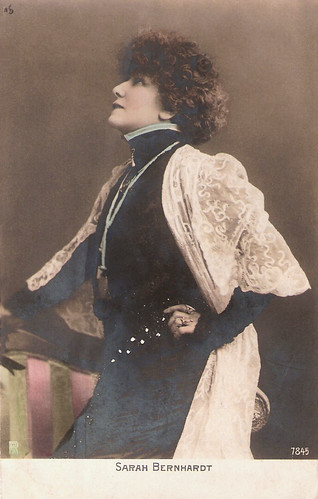
German postcard, no. 7845.
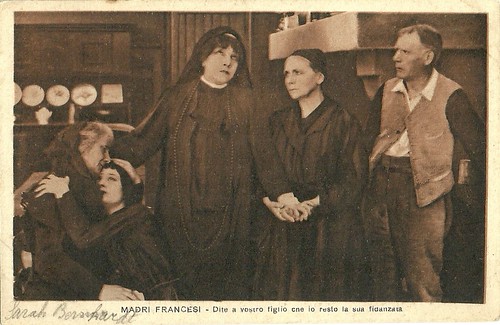
Italian postcard. Sarah Bernhardt as Mme D'Urbex and Louise Lagrange as Marie in the French war propaganda film Mères françaises (René Hervil, Louis Mercanton, 1917). Caption: Tell your son I will remain his fiancee.

Italian postcard. Sarah Bernhardt as Mme D'Urbex and Gabriel Signoret as Guinot in the French war propaganda film Mères françaises (René Hervil, Louis Mercanton, 1917). Caption: Who is near me?
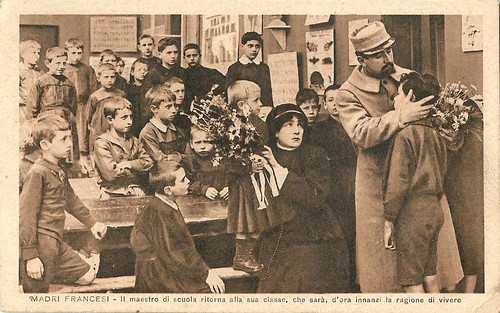
Italian postcard. Sarah Bernhardt as Mme D'Urbex and Gabriel Signoret as Guinot in the French war propaganda film Mères françaises (René Hervil, Louis Mercanton, 1917). Caption: The schoolmaster returns to his class, which henceforth will be his reason to live.
Sequence from Les amours de la reine Élisabeth/Queen Elisabeth (1912). Robert Devereux, the 2nd Earl of Essex (Lou Tellegen) has been executed. Queen Elizabeth (Sarah Bernhardt) visits his corpse, and mourns for him. Source: swagner99 (YouTube).
Sources: Daniel Yates (IMDb), P.K. Hobbs (Everything Vintage), Victor (Wonderings), Wikipedia and IMDb. Film historian Victoria Duckett wrote an excellent book about how Sarah Bernhardt leapt to the early silver screen, Seeing Sarah Bernhardt - Performance and Silent Film. Highly recommended!

French postcard by Raphael Tuck & Fils, Editeurs, Paris, Serie 203. Sent by mail in 1903. Caption: Sarah Bernhardt in Phèdre. Bernhardt played the title role in Jean Racine's Phèdre for the first time in 1874. She retook the part in 1899 when Bernhardt took over the former Théâtre des Nations on the Place du Châtelet. The Théâtre Sarah-Bernhardt opened on 21 January with Victorien Sardou's La Tosca in which Bernhardt played the title role, one of her most admired parts. This was followed by a revival of Phèdre on 24 February.

French postcard. Photo: Downey. Publicity still for the play Le Passant, by François Coppée. In 1869, after her command performance for Napoleon III as as the Florentine minstrel Zanetto (in travesty) in Coppée’s Le Passant, Sarah Bernhardt was on the verge of stardom.

French postcard. Photo: Boyer. Sarah Bernhardt debuted in Alexandre Dumas fils's play La Dame aux Camélias in 1880. It became one of her most beloved and most performed plays. In 1911 Bernhardt would act in a silent film version as well, directed by André Calmettes and Henri Pouctal. This postcard is from the early 20th century. The card depicts the dead Marguerite Gauthier, deplored by her lover Armand Duval.

French postcard. Photo: Downey. Publicity still for the stage production of Maurice Maeterlinck's play Pelléas et Melisande/Pelléas and Melisande in 1904.

French postcard. Photo: H. Manuel. Sarah Bernhardt as Soeur Therese in the play La Vierge d'Avila composed by Reynaldo Hahn and written by Catulle Mendes. 1906 performance at Theatre Sarah-Bernhardt.
The life of a courtesan
Sarah Bernhardt was born in 1844 in Paris as Henriette-Rosine Bernard. Her mother was the Dutch-born Julie Bernardt and her father was unknown. Julie was a courtesan, known by the name Youle. Julie had five daughters, including a twin who died in infancy in 1843. Henriette-Rosine changed her first name and added an 'h' to her surname. Her birth records were lost in a fire in 1871. To prove French citizenship - necessary for Légion d'honneur eligibility - she created false birth records, in which she was the daughter of 'Judith van Hard' and 'Édouard Bernardt' from Le Havre, in later stories either a law student, accountant, naval cadet or naval officer.
When Sarah was young her mother sent her to Grandchamp, an Augustine convent school near Versailles. In 1860 she began attending the Conservatoire de musique et de déclamation in Paris and eventually became a student at the Comédie Française where she would have her acting debut in 1862 in the title role of Jean Racine's Iphigénie to lacklustre reviews. Her time there was short-lived; she was asked to resign after slapping another actress across the face for shoving her younger sister during a birthday celebration for Molière.
Bernhardt decided to leave France, and soon ended up in Belgium, where she became the mistress of Henri, Prince de Ligne, and gave birth to their son, Maurice, in 1864. After Maurice's birth, the Prince proposed marriage, but his family forbade it and persuaded Bernhardt to refuse and end their relationship. She resumed the life of a courtesan to which her mother had introduced her at a young age, and made considerable amounts of money during that period (1862–1865).
Bernhardt then reverted to the theatre, securing a contract at the Théâtre de L’Odéon where she began performing in 1866. Her most famous performance there was her travesty performance as the Florentine minstrel in François Coppée's Le Passant (1869). With the outbreak of the Franco-Prussian War performances were stopped and Bernhardt converted the theatre into a makeshift hospital where she took care of the soldiers wounded on the battlefield. In 1872, she left the Odéon and returned to the Comédie-Française. One of her remarkable successes there was in the title role of Voltaire's Zaïre (1874).

French postcard by Neurdein Frères, Photo-Edit., no. 25. Photo: Nadar. Bernhardt as Empress Theodora in Victorien Sardou’s Theodora (1884).

French postcard by Eclair, no. 25. Photo: Nadar. Publicity still for the 1894 stage play Izéil by Eugène Morand and Armand Silvestre.

French postcard. Bernhardt in the title role of William Shakespeare's Hamlet (1899).

French postcard. Photo: publicity still for a 1900 production of the stage play Cyrano de Bergerac (1900) by Edmond Rostand, in which Bernhardt played the role of Roxane.

French postcard by Raphael Tuck et Fils Ltd Editeurs, Paris, Serie 569. Publicity still for the stage production of Theroigne de Mericourt (1902), a play by Paul Hervieu. Anne-Josèphe Théroigne de Méricourt (1762–1817) was a singer, orator and organiser in the French Revolution. She is known both for her portrayal in the French Revolutionary press and for her subsequent mental breakdown and institutionalisation.
The Divine Sarah
During the 1870s, Sarah Bernhardt made her fame on the European stages and was soon in demand all over the world. Her first tour of the United States and Canada took place in 1880-1881 (157 performances in 31 cities). In 1887 she toured South America. In 1888 she toured Italy, Egypt, Turkey, Sweden, Norway and Russia. In 1891-1892 she took part in a worldwide tour which included much of Europe, Russia, North & South America, Australia, New Zealand, Hawaii and Samoa. Another tour of America took place in 1896. 1901 saw her 6th American Tour, 1906 her 7th (her first 'Farewell Tour'), 1910 her 8th, and 1913-1914 her 9th.
She developed a reputation as a serious dramatic actress, earning the title 'The Divine Sarah'. However, she also participated in scandalous productions such as John Wesley De Kay's Judas. In this play Mary Magdalene, who at first became a lover of Pontius Pilate, then of Judas Iscariot (played by Bernhardt!), got involved with Jesus. Judas, after realising that Mary Magdalene had given herself to Jesus, decided to betray his friend to the Romans. The play performed in New York’s Globe Theatre for only one night in December 1910 before it was banned there, as well as in Boston and Philadelphia.
In between her international tours, Sarah Bernhardt took over the lease of the Théâtre de la Renaissance, which she ran as producer-director-star from 1893 to 1899. She coached many young women in the art of acting. In 1899 Bernhardt took over the former Théâtre des Nations on the Place du Châtelet, renaming it the Théâtre Sarah-Bernhardt. She opened it in the title role in Victorien Sardou's La Tosca and many of her famous roles, such as her Hamlet in travesty, followed.
Bernhardt continued to direct the Théâtre Sarah-Bernhardt until her death, when her son Maurice took over. After his death in 1928, the theatre retained the name Sarah Bernhardt until the Occupation by the Germans in World War II, when the name was changed to Théâtre de la Cité because of Bernhardt's Jewish ancestry.

British postcard by Rotary Photo Co., London, no. 228C.

British postcard by Rotary Photo Co., London, no. 228A. Sent by mail in 1905. Photo: Reutlinger, Paris.

French postcard by S.I.P., Paris. Photo: Reutlinger.

Tinted, vintage postcard. Collection: phheww.

German postcard, no. 2329. It was sent from Leipzig, Germany to Laibach, Austria (now Ljubljana, Slovenia) on 31 October 1905. The author used the Greek alphabet. We deciphered the text and discovered that he wrote in German and signed as Hugo Reizenbach. The addressee was one Christl Kantz, maybe his secret girlfriend?
Sarah by Reutlinger
The beautiful postcards above are probably the best known images of Sarah Bernhardt. On each postcard she wears the same outfit and a huge crown-like diadem. This 'Lilies' diadem for was designed by poster designer Alphonse Mucha and created by the famous French jewelry designer René Lalique.
The photographs for the postcards were made by the Reutlinger Studio in Paris, which took photos of the rich and famous between 1850 and 1937. The Reutlinger studio was founded in 1850 by German-born photographer Charles Reutlinger. In 1880, he passed the studio on to his brother Emile, who ran the studio until 1890. In 1883, Emile’s son Léopold came to Paris from Callao, Peru, where he grew up. Léopold Reutlinger took over in 1890, and he developed a very successful postcard business.
P.K. Hobbs at Everything Vintage: "Léopold introduced a very distinctive style of merging photographic images with art nouveau fantasy overlays. He added to that process exceptionally well-done hand tinting. The Reutlinger Studio became known for their unusual art nouveau styles of postcard designs, especially for portraits of actresses. These postcards were not cheaply produced, nor were they cheaply sold. This part of his business was very successful and sought-after, as thousands of his art nouveau postcards were produced."
The photos for the postcards above were publicity stills for the stage play La princesse Lointaine by Edmond Rostand. Sarah Bernhardt wore the diadem for the first time in this play at the Renaissance Theatre in Paris in 1895.

French postcard. Sent by mail in 1906. Photo: Boyer, Paris. Publicity still for the play Théroigne de Méricourt, by M. Paul Hervieu, presented at the Théâtre Sarah Bernhardt in 1902.


French postcards, both sent by mail in 1908. Photos: publicity stills for her stage play L'aiglon.

French postcard. Photo: Sarah Bernhardt in L'Aiglon. L'Aiglon is a play in six acts by Edmond Rostand based on the life of Napoleon II, who was the son of Emperor Napoleon I and his second wife, Empress Marie Louise. The title of the play comes from a nickname for Napoleon II, the French word for 'eaglet' (a young eagle). The title role was created by Sarah Bernhardt in the play's premiere on 15 March 1900 at the Théàtre Sarah Bernhardt. Rostand had written L'Aiglon specifically for Bernhardt, and it became one of her signature roles.

French postcard by F.C. & Cie, no. 125. Photo: Manuel. Sarah Bernhardt as Soeur Therese in La Vierge d'Avila composed by Reynaldo Hahn and written by Catulle Mendes. 1906.
A sporadic love-hate affair with cinema
Sarah Bernhardt had a sporadic love-hate affair with the early cinema. In 1900, she made her first film, the two-minute long Le Duel d'Hamlet/Hamlet (Clément Maurice, 1900). Technically, this was not a silent film, as it had an accompanying Edison cylinder with sound effects.
After her film début Bernhardt declared she detested the medium. However, in the following decades she consented to star in eight motion pictures and two biographical films. The latter included Sarah Bernhardt à Belle-Isle/Sarah Bernhardt at Home (1912), a film about her daily life with her family and friends.
In 1908 she featured in her second film, based on Victorien Sardou's Tosca, condensed to a one-reel film. Upon seeing La Tosca (1909), she reportedly recoiled in horror, demanding that the negative be destroyed.
Nevertheless, soon followed her leading role in the Film d'Art production La dame aux camélias/Lady of the Camelias (Louis Mercanton, 1911), released in the US as Camille. It was a two-reel condensation of the play with handsome Dutch actor Lou Tellegen as Armand Duval. The film was a critical and popular success, and it helped to give the cinema artistic dignity.
The handsome Dutch-born Lou Tellegen was again Bernhardt's co-star in her next film, Les amours de la reine Élisabeth/Queen Elisabeth (Henri Desfontaines, Louis Mercanton, 1912), filmed in Britain. The massive receipts from this film's distribution in the US provided Adolph Zukor with the funds to found Paramount.
Bernhardt, at 69, was offered a fortune to make films with other companies, but she stayed with Film d'Art. She next appeared in Adrienne Lecouvreur (Henri Desfontaines, Louis Mercanton, 1913) with Max Maxudian and again Lou Tellegen.

French postcard by S.I.P., 72e Serie, no. 7.

French postcard by S.I.P., series 72, no. 8.

French postcard by BJC, Paris. Sent by mail in 1904.

French postcard. Sarah Bernhardt and colleague Benoît-Constant Coquelin, known as Coquelin aîné (Coquelin the Eldest), known as one of the greatest theatrical figures of the age. In 1900 Bernahardt and Coquelin toured together in America. They appeared on Broadway's Garden Theatre in a production of Cyrano de Bergerac (Coquelin as Cyrano and Bernhardt as Roxane). On their return to France they appear together in L'Aiglon, at the Théâtre Sarah Bernhardt.

French postcard by PMM. Photo: Nadar, Paris. Sent by mail in 1901.
War propaganda films
During the First World War, Sarah Bernhardt played in two war propaganda films, the intimate drama Jeanne Doré (René Hervil, Louis Mercanton, 1915) and the highly patriotic Mères françaises/Mothers of France (René Hervil, Louis Mercanton, 1917).
In between these two films, she had lost a leg. In 1905, while performing in Victorien Sardou's La Tosca in Teatro Lírico do Rio de Janeiro, Bernhardt injured her right knee when jumping off the parapet in the final scene. The leg never healed properly. By 1915, gangrene set in and her entire right leg was amputated; she was required to use a wheelchair for several months.
Bernhardt continued her career, sometimes without using a wooden prosthetic limb, which she did not like. She carried out a successful tour of America in 1917 (her 10th), and on returning to France she played in her own productions almost continuously until her death. Later successes included Daniel (1920), La Gloire (1921), and Régine Armand (1922). The amputation was not apparent during her performances, which were done with the use of the artificial limb. The charm of her voice, which had altered little with age, ensured her triumphs.
Her last film was La Voyante/The Fortune Teller (Leon Abrams, Louis Mercanton, 1923) with Harry Baur. By then she was 79 and already mortally ill. Her hotel room was turned into a studio. But her failing health halted production and she died before the film was completed. Her stand-in had to complete her scenes, with her back to the camera.
Sarah Bernhardt passed away on 26 March 1923 in Paris. The cause of death was uraemia (urea in the blood) following after kidney failure. From 1882 till 1898 (his death), she had been married to the Greek diplomat Ambroise Aristide Damala, who was 12 years younger than his wife. Newspaper reports stated she died "peacefully, without suffering, in the arms of her son". She is believed to have been 79 years old. Sarah Bernhardt is buried at the Cimetière du Père Lachaise.

German postcard, no. 7845.

Italian postcard. Sarah Bernhardt as Mme D'Urbex and Louise Lagrange as Marie in the French war propaganda film Mères françaises (René Hervil, Louis Mercanton, 1917). Caption: Tell your son I will remain his fiancee.

Italian postcard. Sarah Bernhardt as Mme D'Urbex and Gabriel Signoret as Guinot in the French war propaganda film Mères françaises (René Hervil, Louis Mercanton, 1917). Caption: Who is near me?

Italian postcard. Sarah Bernhardt as Mme D'Urbex and Gabriel Signoret as Guinot in the French war propaganda film Mères françaises (René Hervil, Louis Mercanton, 1917). Caption: The schoolmaster returns to his class, which henceforth will be his reason to live.
Sequence from Les amours de la reine Élisabeth/Queen Elisabeth (1912). Robert Devereux, the 2nd Earl of Essex (Lou Tellegen) has been executed. Queen Elizabeth (Sarah Bernhardt) visits his corpse, and mourns for him. Source: swagner99 (YouTube).
Sources: Daniel Yates (IMDb), P.K. Hobbs (Everything Vintage), Victor (Wonderings), Wikipedia and IMDb. Film historian Victoria Duckett wrote an excellent book about how Sarah Bernhardt leapt to the early silver screen, Seeing Sarah Bernhardt - Performance and Silent Film. Highly recommended!
Incredible images. I'm a huge vintage...ah collector/admirer. I collect more books than postcards but that is only because I have trouble finding the postcards. These are wonderful
ReplyDeleteOh, these are beautiful. Love all things vintage.
ReplyDeleteDebby
I love your posts. I love your postcards as well, but all the background information is fabulous.
ReplyDeleteI look forward to next week. :-)
Have a beautiful weekend.
Sarah Bernhardt is such a well known name in Paris! There are many streets named after her and of course the famed Sarah Bernhardt theater but... I have never scene the silent movie tidbits and I didn't even know what she looked like! This is invaluable BOB!
ReplyDeleteThank you so very much for the great information and fantastic post.I am always so happy to come and see what you have found.
ReplyDeleteI don't know how you do it.
Happy PFF to you.I do enjoy the silents .They are a work of art.
Again thank you for this great
vintage post today. I loved it !
Have a fabulous weekend.
How fabulous!
ReplyDeleteTruly a "Divine" post!
ReplyDeleteI Love her ornate outfit... and I really enjoyed the history you shared, as well... Thanks so much!
~blessings~
Pearl
Thank you all for your comments. Till next PFF Friday. Love you.
ReplyDeleteThis week I'll be blogging about film stars who were also once a participant of a huge, typical European extravaganza:
The Eurovision Song Contest.
It's an unknown event for most Americans, I guess. But for many of us in Europe it's great fun. For many people it's a glamorous, and very exciting singing competition but for others it's our yearly campy party with incredibly silly acts, the weirdest hairdos and dresses imaginable, and youth sentiment.